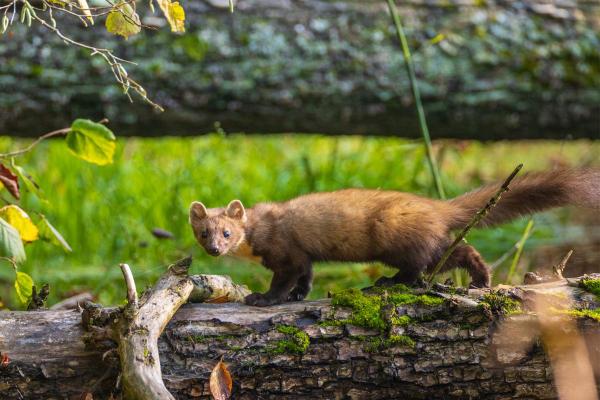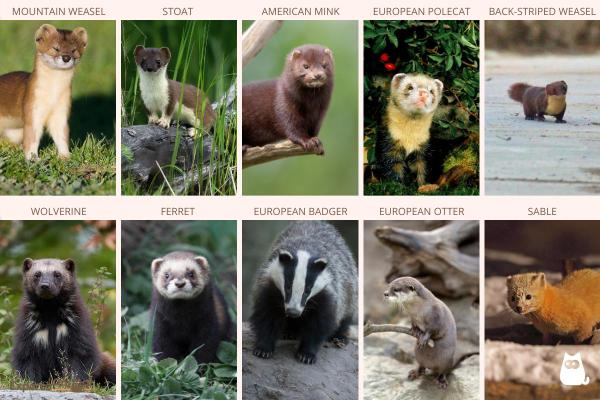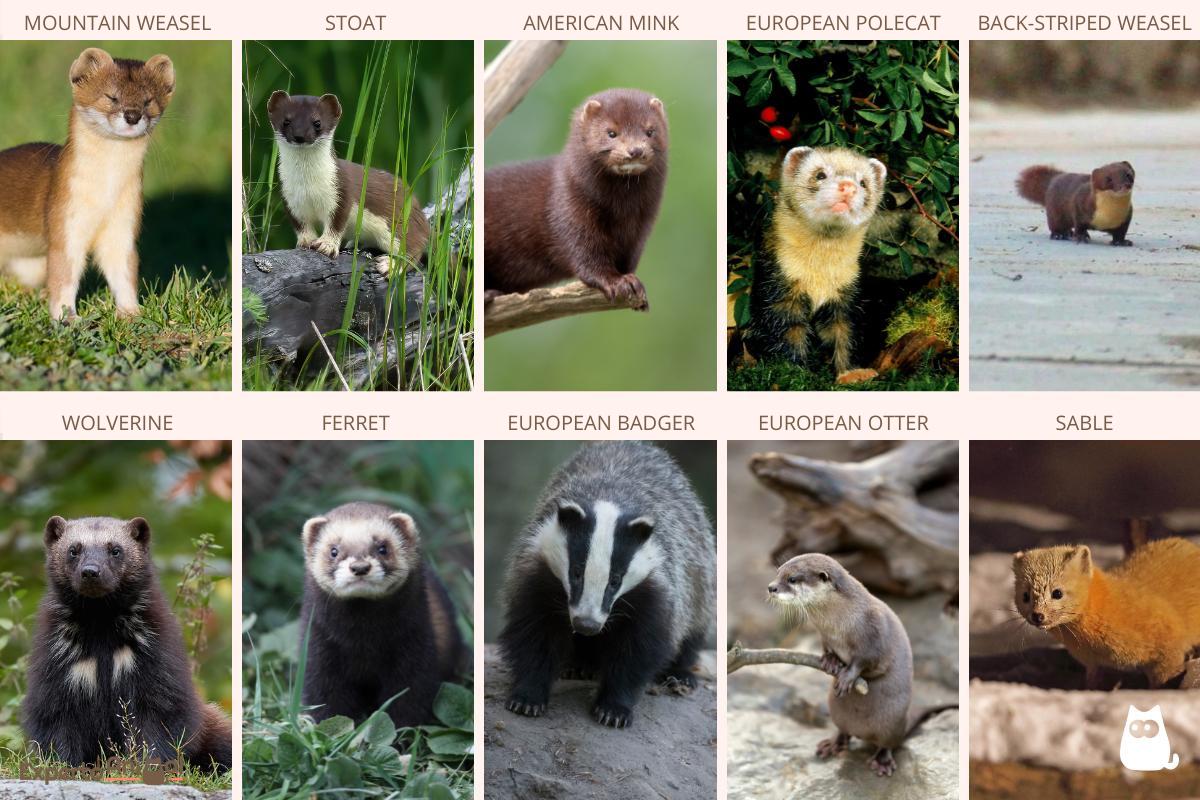Types of Mustelids - Examples of Mustelid Species


If you know any types of mustelids, you are most likely aware of weasels and ferrets. Although these are two of the most emblematic mustelid species, the family Mustelidae is a much more diverse group of carnivorous mammals. While there are many differences between different types of mustelids, there are also many similarities which is the reason they are grouped together. All members have their own morphological and ecological adaptations which have allowed them to survive in their various ecosystems. For this reason, they are widely distributed around the world in a range of habitats. Such habitats include forests, tundras, deserts, grasslands and even aquatic environments.
With AnimalWised, we look at the different types of mustelids. We provide examples of mustelid species with photos, characteristics and more information on mustelid classification.
What are mustelids?
Mustelids are a family of carnivorous mammals belonging to the order Carnivora. Characterized by their elongated bodies and short limbs with rounded ears, mustelids encompass a diversity of species adapted to various environments. Among their best-known examples of mustelids are the weasel, ferret, mink, otter, wolverine and stoat.
These mammals exhibit a wide variety of morphological and behavioral characteristics. For example, weasels and stoats are very agile hunters, being able to kill prey much larger than themselves. Wolverines and badgers are more robust, but no less adept at killing. The Mustelidae family also includes skilled swimmers, such as the otter. These types of mustelid prefer aquatic habitats such as rivers, lakes and coastal areas.
While it is difficult to determine the exact reason for the evolutionary success of mustelids, there are certain traits which predispose them to survival. One is their ability to occupy a wide range of habitats, both terrestrial and aquatic. Many species have varied diets, feeding on prey such as rodents, birds, fish and insects. While mainly carnivorous, some mustelids have adapted to eat some plant matter, especially during times of scarcity.
Efficient hunting, agility and versatility in choosing prey are distinctive characteristics of mustelids. We look at the characteristics of these types of carnivorous animals in more detail in the sections below.

Characteristics of mustelids
As already stated, different types of mustelid species have their own specific characteristics. However, there are several distinctive characteristics of this mammal family which contribute to their adaptive success in nature, these include the following:
- Elongated and flexible morphology: mustelids usually have elongated and flexible bodies with short legs, rounded ears and long tails. This morphology provides them with agility and flexibility in their movements, making it easier for them to hunt and explore various habitats.
- Dense and soft fur: many species of mustelids have dense, soft fur that provides them with thermal insulation. Sea otters have particularly dense fur to help them survive the sometimes near-freezing oceanic conditions. Coat colors vary depending on the species and can include shades of brown, black, white, and other colors. These can aid in camouflage and adaptation to their environment.
- Scent glands: mustelids have well-developed scent glands, especially anal glands. They use them to mark their territory and communicate with other individuals of their species. These secretions may also have functions in mating behavior and territorial defense.
- Carnivorous habits: mustelids are carnivorous animals that feed on a variety of prey, such as rodents, birds, fish and insects. Some species, such as the weasel, are known to hunt prey larger than themselves using cunning tactics.
- Adaptability to different habitats: mustelids show remarkable adaptability to different environments, from terrestrial forests, grasslands and arboreal area, to aquatic rivers, lakes and oceans. This versatility allows them to inhabit a variety of ecosystems around the world.
- Solitary or social behavior: the social behavior of mustelids varies depending on the species. Some are solitary and territorial, like the weasel. Others can be more social and live in family groups, like the otter. Even within these types of mustelid, there is variation. River otters tend to be more gregarious than sea otters.
When we consider these different characteristics of mustelids, we can see why they are so ecologically successful in their various ecosystems. A factor we haven't mentioned about mustelids is their danger. Learn more with our article on the most aggressive animals in the world.
Classification of mustelids
The classification of mustelids is organized hierarchically according to biological taxonomy . Here is a general classification, but keep in mind that the taxonomy may change due to ongoing scientific research and review:
- Kingdom: Animalia
- Phylum : Chordata
- Subphylum: Vertebrata
- Class: Mammalia
- Order: Carnivora
- Family: Mustelidae
Within the Mustelidae family there are several subfamilies and genera that contain the different species of mustelids. In this way, we can talk about the lower classifications of mustelids which provide more specific taxonomic groups. We start with the largest mustelid subfamily known as Mustelinae:
Subfamily Mustelinae
- Genus Lyncodon (Patagonian weasel)
- Genus Neovison (American mink)
- Genus Vormela (marbled polecat)
- Genus Poecilogale (African striped weasel)
- Genus Mustela (weasel)
Subfamily Lutrinae
- Genus Aonyx (Asian small-clawed otter)
- Genus Hydrictis (Speckle-throated otter)
- Genus Lontra (South American river otter)
- Genus Pteronura (Giant otter)
- Genus Lutra (Eurasian otter)
- Genus Lutrogale (Smooth-coated otter)
- Genus Enhydra (Sea otter)
Subfamily Guloninae
- Genus Eira (tayra)
- Genus Gulo (wolverine)
- Genus Martes (marten)
Subfamily Ictonychinae
- Genus Ictonyx (striped polecat)
- Genus Galictis (grison)
Subfamilies Melinae, Helictidinae, Mellivorinae and Taxideinae
- Genus Mellivora (honey badger)
- Genus Meles (Eurasian badger)
- Genus Arctonyx (hog badger)
- Genus Melogale (ferret-badger)
- Genus Taxidea (American badger)
These are some of the best-known mustelid genera. Their classification may vary as new research is carried out and more data is obtained. It should be noted that some species, such as mink, have been introduced to regions outside their natural distribution, which can affect population dynamics and local ecosystems.
Learn more about the behavior of certain types of mustelid with our article on whether otters are dangerous.

Types of mustelids
Now we know the taxonomic classification of mustelids, we can look at some of the most emblematic types of mustelid species. Some of the most well- known mustelid examples are the following:
- Weasels: this type of mustelids are characterized by being agile predators and adapted to a variety of habitats. They have the characteristics of typical mustelids such as thin, elongated bodies and short legs. Within this group of mustelid types we find the least weasel (Mustela nivalis) and the stoat (Mustela erminea).
- Polecats: these include the European polecat (Mustela putorius). You may be more aware of the domestic type of polecat known as the ferret, derived from this European polecat species. They are usually born and raised as companion animals, but are also used for hunting rabbits or vermin. Learn about the different types of ferrets.
- Minks: some examples include the American mink (Neovison vison) and the European mink (Mustela lutreola). Minks are often a type of aquatic mustelid, being most associated with aquatic habitats. They are appreciated for their fur, which is very thick and dense. Unfortunately, they have traditionally been used in the fashion industry for their fur.
- Wolverines: This type of mustelid is known for its robust size and resistance in subarctic environments. They are also known as carcajous, quickhatches or gluttons. The latter is due to their ability to eat a lot of prey.
- Martens: includes species such as the American marten (Martes americana) and the sable (Martes zibellina). Martens are agile and versatile animals that can inhabit both forests and open areas. Unfortunately, sables are also highly sought out for their fur. Discover what pine martens eat if you want to know the specific dietary habits of this mustelid.
- Otters: examples include the European otter (Lutra lutra) and the North American otter (Lontra canadensis), known for being skilled swimmers and spending much of their time in the water. They feed mainly on fish and some crustaceans. Find out more about the different types of otters in our related guide.
These types of mustelids represent different genera and encompass a diversity of species. Each type of mustelid has specific adaptations for its environment and a particular role in the ecosystem in which it is found.
Other examples of mustelids
Mustelids comprise a wide variety of species, each adapted to specific habitats and with distinctive characteristics. Here are some more examples of mustelids according to the type to which they belong, each one representing different genera and species within the family Mustelidae. You can see some photos of these mustelids below.
- Mountain weasel (Mustela altaica)
- Columbian weasel (Mustela felipei)
- Indonesian mountain weasel (Mustela lutreolina)
- European polecat (Mustela putorius)
- Back-striped weasel (Mustela strigidorsa)
- European badger (Meles meles)
- Japanese badger (Meles anakuma)
It should be noted that there are up to 66 different mustelid species that are extant. These do not include the various extinct species. Many types of mustelid are found in abundance thanks to their adept hunting ability. However, there are also some which are under threat. Some are even considered endangered.
Vulnerable or endangered mustelids include the European mink, sea otter, giant otter, marbled polecat and the Siberian weasel. The reasons for their conservation status are varied, but they are often related to human interventions in their ecosystems which lead to habitat loss and environmental degradation. The hunting of various mustelids for their fur still occurs, but thankfully to a lesser degree.
While the vast majority of mustelids are not able to kept as companion animals, ferrets are arare exception.

If you want to read similar articles to Types of Mustelids - Examples of Mustelid Species, we recommend you visit our Facts about the animal kingdom category.
- Baskin, J. A. (1998). Mustelidae. Evolution of Tertiary Mammals of North America: Volua.
- Koepfli, K. P., at al. (2008). Multigene phylogeny of the Mustelidae: resolving relationships, tempo and biogeographic history of a mammalian adaptive radiation. BMC biology, 6, 1-22.
- Kollias, G.V., & Fernandez-Moran, J. (2015). Mustelidae. Fowler's Zoo and Wild Animal Medicine, 8, 476.
- Yonezawa, T., Nikaido, M., Kohno, N., Fukumoto, Y., Okada, N., & Hasegawa, M. (2007). Molecular phylogenetic study on the origin and evolution of Mustelidae. Gene, 396(1), 1-12.







